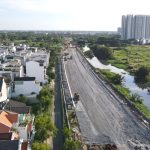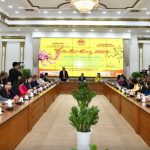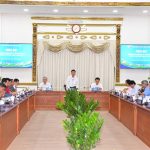On August 10, in Ho Chi Minh City, Prime Minister Pham Minh Chinh, Chairman of the Southeastern Region Coordination Council (the Council), chaired the Council’s fourth meeting to review the implementation of the tasks set at the third meeting and deploy the Southeastern Region Planning for the 2021-2030 period, with a vision towards 2050.
ASSERTING ITS POSITION AS ONE OF THE COUNTRY’S ECONOMIC POWERHOUSES
At the meeting, the Ministry of Planning and Investment reported on the Council’s activities in 2024. The Ministry of Science and Technology presented the implementation of the project to establish and promote the development of a startup innovation and artificial intelligence center in Ho Chi Minh City, Binh Duong province, and Dong Nai province.
The Ministry of Information and Communications reported on the implementation of the project to build an information technology industry hub, attracting investment in the production of electrical, electronic, Internet of Things (IoT), and AI products in Dong Nai, Binh Duong, and Ba Ria-Vung Tau provinces.
Ba Ria-Vung Tau province reported on the progress of the project to study a free trade area associated with the port in the Cai Mep Ha area. Dong Nai province presented on the development of transportation connections to Long Thanh International Airport. The Ho Chi Minh City People’s Committee proposed a plan to complete the city’s urban railway network.

Three months ago (on May 5, 2024), the Council’s third meeting in Tay Ninh province reviewed the implementation of Resolution No. 24-NQ/TW of the Politburo and the Government’s Action Program No. 154/NQ-CP on socio-economic development and ensuring national defense and security in the Southeastern region. It also announced and deployed the Southeastern Region Planning for the 2021-2030 period, with a vision towards 2050, reviewed regional special mechanisms and policies, and assessed the implementation of key inter-regional projects.
According to the reports and opinions at the meeting, of the nine tasks assigned at the May meeting, three have been completed: (i) the Can Gio international transit port has been added to the master plan for the development of Vietnam’s seaport system for the 2021-2030 period, with a vision towards 2050; (ii) the investment policy for the Ho Chi Minh City-Moc Bai highway project (phase 1) has been approved under the public-private partnership format; and (iii) the National Assembly has issued a resolution approving the investment policy for the Chon Thanh-Gia Nghia highway project.
Additionally, the region’s socio-economic development results over the past time continue to affirm the important position and role of the Southeastern region as one of the country’s economic powerhouses, leading in innovation, creativity, dynamism, and development.
Although it accounts for only over 9% of the country’s area, the Southeastern region contributes about one-third of GDP and more than 44% of the state budget revenue. Total state budget revenue in the first seven months of 2024 reached VND 452,000 billion, ranking second after the Red River Delta region. Export value reached over USD 59.2 billion, accounting for 31% of the country’s total export value, second only to the Red River Delta region (nearly 35%).
The Southeastern region has the largest number of newly established and reactivated enterprises among the six economic regions, with 58,246 enterprises, an increase of 9.8%. The region continues to lead the country in both the number of projects and the total foreign direct investment capital, with 20,000 projects and USD 187.4 billion, respectively, as of July 20, 2024. Ho Chi Minh City ranks first in the country, accounting for nearly 32% of the projects and almost 12% of the registered capital.
Up to now, all six localities in the region have completed and submitted their master plans for approval, and five out of six provincial planning schemes have been approved by the Prime Minister.
URGING THE START OF CONSTRUCTION OF KEY EXPRESSWAY PROJECTS
Concluding the meeting, Prime Minister Pham Minh Chinh agreed with the contents of the reports and the opinions expressed. He assigned the Ministry of Planning and Investment to coordinate with the Government Office and relevant ministries and localities to research and maximize the opinions raised to continue advising the Southeastern Region Coordination Council effectively in implementing the regional planning in the coming time.
The Prime Minister applauded the efforts of the Council members, ministries, sectors, and localities in completing three critical tasks after the third meeting. He acknowledged, commended, and highly appreciated the determination, efforts, and sense of responsibility of the leaders, people, and businesses of the Southeastern region, with a proactive, positive, creative, and innovative spirit, achieving important results and contributing to the country’s overall achievements in the past time.
At the same time, the Prime Minister pointed out that the development process of the Southeastern region in the past time has also faced some limitations, difficulties, and challenges.
The region’s economic growth in the first six months was only 5.58%, lower than the national average and higher only than the Central Highlands region (3.86%). The growth model is slow to transform, and the region’s growth momentum is slowing.
The quality of the region’s economic growth is not truly sustainable due to a lack of resilience and timely solutions to negative external factors.
Industry, one of the region’s three critical pillars, is developing unsustainably, with low added value, uneven distribution, and heavy reliance on foreign-invested enterprises.
Environmental pollution and flooding are pressing issues but have seen slow improvements, especially in Ho Chi Minh City. The business and investment environment and competitiveness remain limited, and regional connectivity needs to be strengthened.

To enhance the effectiveness of implementing the regional planning in the coming time and maximize the region’s potential and advantages, the Prime Minister emphasized several orientations and tasks.
Accordingly, ministries, sectors, and localities need to be proactive and active in completing the assigned tasks with quality under the Government’s resolutions and the decisions of the Chairman of the Council on the 2023 and 2024 plans of action. They should closely follow the situation and provide timely policy advice.
Regarding common and key tasks, the Prime Minister requested that ministries, sectors, and localities, according to their functions, tasks, and powers, review the targets and indicators set for 2024 to make determined efforts to fulfill them, contributing to promoting growth, stabilizing the macro-economy, and controlling inflation, while ensuring major balances.
At the same time, they should actively and resolutely implement planning work, review legal bottlenecks and obstacles in practice, and propose amendments to several laws, especially the Law on Public Investment. It is necessary to promote the disbursement of public investment capital to leverage private investment and activate all social resources.
Along with this, focus on promoting the three traditional growth drivers (investment, exports, and consumption) and fostering new growth drivers (such as digital transformation, green transition, circular economy, sharing economy, knowledge-based economy, semiconductor chips, hydrogen, artificial intelligence, etc.). Ensure close coordination between ministries, sectors, and localities to address difficulties and challenges and strengthen regional linkages.
“Promote the disbursement of public investment capital, innovation and creativity, and the application of science and technology and the Fourth Industrial Revolution, focusing on emerging industries. Enhance the training of high-quality human resources, thus contributing to realizing one of the three strategic breakthroughs set by the 13th National Congress of the Communist Party of Vietnam,” the Prime Minister emphasized.
Regarding specific tasks, the Prime Minister requested that the Ministry of Planning and Investment soon organize a conference to review two years of implementing the Politburo’s resolutions on the development of socio-economic regions and, on that basis, issue a Directive of the Prime Minister on regional development.
Ministries, sectors, and localities assigned to lead the study of regional and inter-regional projects, including the project to establish an international financial center in Ho Chi Minh City, a free trade center in Ba Ria-Vung Tau, and connecting road systems, should promptly complete their tasks.
The Prime Minister assigned Ho Chi Minh City to take the lead in submitting superior mechanisms and policies within the competence of the National Assembly for the Ho Chi Minh City Ring Road 4 project at the Council’s meeting in November 2024.
Ho Chi Minh City, Binh Duong, Tay Ninh, and Binh Phuoc should promptly complete the next procedures for the Ho Chi Minh City-Moc Bai, Chon Thanh-Gia Nghia, and Ho Chi Minh City-Thu Dau Mot-Chon Thanh expressways, striving to start construction on the occasion of April 30, 2025.
The relevant agencies should continue studying, reviewing, and amending the integration and amalgamation of mechanisms and policies, including those on resource mobilization, especially for localities in the Southeastern region with high revenue potential. This will create favorable conditions for infrastructure investment, especially in expressways and national highways and projects passing through the provinces, to prepare for investment in the next phase.
In the afternoon of August 10, in Ho Chi Minh City, Prime Minister Pham Minh Chinh inspected the construction progress of the T3 Passenger Terminal project at Tan Son Nhat International Airport and attended the inauguration ceremony of a new tunnel in front of the airport entrance. This was the third time Prime Minister Pham Minh Chinh visited the project site.
The T3 Passenger Terminal project at Tan Son Nhat International Airport is invested by the Airports Corporation of Vietnam (ACV) with a total investment of about VND 10,990 billion from ACV’s legal capital (without using the state budget). The construction period is expected to be 37 months from the approval of the investment policy.
At the project site, Prime Minister Pham Minh Chinh praised the efforts of the relevant agencies, ACV as the investor, and the contractors in implementing the project, making up for the previous delay, and especially the 3,000 enthusiastic construction workers.
To achieve the goal of ensuring the quality and efficiency of the project and putting it into operation on the occasion of April 30, 2025, celebrating 50 years of the liberation of the South and the unification of the country, the Prime Minister requested that ACV focus its human resources, including those of the investor, consulting units, and contractors, and coordinate with relevant agencies to continue promoting the spirit of “only discuss doing, not discuss backing down,” “overcome the sun, win against the rain,” “eat in a hurry, sleep in a hurry,” working in “3 shifts and 4 groups,” and working continuously during holidays and Tet to complete the project on schedule.
In the afternoon, the Prime Minister attended the inauguration of Package 9 of the project to build a road connecting Tran Quoc Hoan and Cong Hoa streets in Tan Binh district, Ho Chi Minh City, and launched a 130-day emulation movement to accelerate the progress and complete the entire road route by December 31, 2024, ready to serve the T3 terminal when it becomes operational.
Comprehensive regional connectivity
In addition to building strong physical infrastructure, Ho Chi Minh City needs to strengthen its soft connections with other provinces in the region in order to promote economic development. This includes prioritizing the training of skilled workforce and ensuring access to quality healthcare.
Emotional Kieu people when admiring Ho Chi Minh City from Metro Line 1
Ho Chi Minh City has undergone a remarkable transformation since the day I left. It now boasts a completely different appearance, exuding a fresh and vibrant energy. This sentiment was captured by Mr. Nguyen Duong Nam Phuong, a Vietnamese American, who was amazed by the city’s newfound liveliness.




















